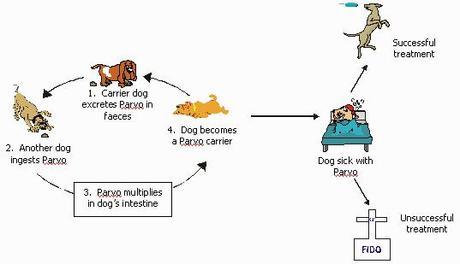 Sick puppy: image via encinavet.comThe economy is hurting pets in some ways, even though pet businesses are one of the few growing enterprises in this recessionary period. There are more pet adoptions, and that is great, but there are also more dogs that are not under the care of a veterinarian or any consistent pet health program - perhaps because owners cannot afford the fees. We see the lack of medical care in the spread of one of the most serious canine contagious diseases, canine parvovirus, or parvo, which is currently experiencing a resurgence, and which is preventable.
Sick puppy: image via encinavet.comThe economy is hurting pets in some ways, even though pet businesses are one of the few growing enterprises in this recessionary period. There are more pet adoptions, and that is great, but there are also more dogs that are not under the care of a veterinarian or any consistent pet health program - perhaps because owners cannot afford the fees. We see the lack of medical care in the spread of one of the most serious canine contagious diseases, canine parvovirus, or parvo, which is currently experiencing a resurgence, and which is preventable.
From every part of the U.S. - California, Wisconsin, Tennessee, Alabama, and other states - and from Canada, Australia, and New Zealand, have come reports of epidemics of canine parvovirus during the last month. Some shelters had to be closed down because of the disease. Whether the disease is spreading through a shelter, a kennel, dog parks, beaches, and other places that dogs congregate, it's spreading, and some dogs, particularly puppies have not survived the ravages of parvo.
Canine parvovirus can be found anywhere, in any environment. The virus attacks a dog's intestinal lining absorbing nutrients and water from the body and kill white blood cells. It lives in the saliva, vomit, and feces of infected dogs; thus any other dog that comes in contact with these infected body fluids or solids, contaminated soil, or other infected materials can be contaminated with the virus, if not vaccinated against it.

The disease is not pretty. Between 3 and 14 days after exposure, a dog will exhibit symptoms including bloody diarhea, lethargy, loss of appetite, dehydration... even shock or death in extreme cases. Dogs with any of these symptoms should be seen as soon as possible by a veterinarian and tested for the parvovirus. There is no 'medication' for parvovirus, but it must be treated with supportive care, such as antibiotics to help with bacterial infections, IV fluids, anti-nausea medicines and nutritional support. Dogs with advanced cases of parvo may require plasma or blood transfusions.
Puppies need to be vaccinated with the complete set of parvo shots, which are given three times during the first 13 weeks of a pup's life. Then, yearly, dogs need to receive boosters for the disease. Puppies are at higher risk of death because their immune systems are not completely developed; therefore, it is advised that dogs under the age of five months not be exposed to unknown dogs in possibly contaminated areas like dog parks.
Breeds that are especially susceptible to canine parvovirus include Rottweilers, Dobermans, Pit Bulls, Labs, German Shepherds, Springer Spaniels, and Alaskan sled dogs.
sources: Northern Life, Encina Veterinary Hospital, PetMD, Gemstone Rottweiler

